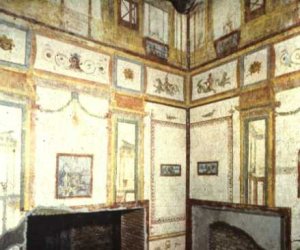
DOMVS AVREA
The Domus Aurea, or "golden house", located between the Esquiline
and Palatine Hills, was one of Nero's most extravagant
projects. After two-thirds of Rome were destroyed by the great fire in 64 AD, Nero used
this land as a site for his new palace. It was not so much a palace as a series of
buildings scattered over a landscaped "countryside" which included an artificial
lake. The main building was extravagantly crafted, and boasted rooms and hallways
decorated almost entirely in gold. In the case of the Domus, we know the names of
the architects in charge of the project, Severus and Celer, and that of Fabullus,
the painter who decorated many rooms.
Remains of the Domus Aurea - the grotesque style has influenced Renaissance artists
One of the most visible (and arrogant) features of the Domus Aurea was the Colossus Neronis: a 36 meter (120 ft) high bronze statue of Nero placed just outside of the entrance. This monstrosity was built in imitation of the Colossus of Rhodes, one of the Seven Wonders of the Ancient World. The Colossus was later on affixed with the heads of several emperors, until Hadrian moved it to the Amphitheatrum Flavium (it seems that this could be the origin of the name Colosseum, which started to indicate the amphitheatre in the XI century).
The area of the property was 985 feet long by 295 feet in width or depth. Among the rest there was an amphitheatre, a market, and bath-gymnasium complex, served by an aqueduct 75 Km (50 miles) long. Baths were served by a flow of both salt and sulphurous water from the Albulae springs. Upon the Caelian Hill there were beautiful gardens, zoos, woods and parks where cattle roamed . There were hundreds of statues, grottoes, nymphaeums, porticoes painted with romantic landscapes; multiple waterfalls flowed all over. The lake - where the Colosseum was later built - was surrounded by woods and fake sea villages, and it was so big that ship could manoeuvre in it. The rooms of the palace were decorated with rare stones and mother of pearl; in the banquet rooms the guests were inundated by flowers and perfumes from the ivory ceilings (R. Lanciani, Rovine...). One of the most famous of these rooms featured a circular roof painted with the stars and the planets, that revolved mechanically imitating the movement of the stars.
After the death of Nero, Vespasian reopened the property to the public, and the palace of Nero was accordingly covered by the Southern part of the baths of Titus and Trajan. Enormous foundations were placed in the palace of Nero to support the new building, and this also helped to preserve what remained of the Domus. The ruins have been visited since the XV century, and its paintings have been an inspiration for many artists (i.e. Raphael in his decoration of the Logge Vaticane) who have left their graffiti in the walls. The Domus Aurea was then called "le grotte", and this seems to be the origin of the term "grottesco" (grotesque).
A part of the Domus Aurea has been recently reopened to the public, after many years of restoration.